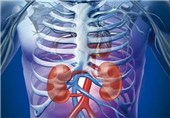Men with Midriff Fat in Greater Danger of Dying from Prostate Cancer
TEHRAN (Tasnim) – A man with 40inch (103cm) waist or above has a 35 per cent higher risk of dying from prostate cancer than one who wears a 35inch (90cm) or lower trouser size, a research suggests.
The Oxford University study, looking at more than 200,000 men, did not find an increased risk in people with higher overall body fat if it was spread around the body.
This suggests it is the specific location of the fat that makes males more prone to the killer disease.
Fat stored in the belly is considered the most dangerous type because it coats vital organs, such as the liver, pancreas and intestines.
This may interfere with their normal function and promote the growth of cancerous cells, the researchers said.
The latest research, presented at this year's European and International Conference on Obesity (ECOICO), looked at 218,225 cancer-free men in the UK, whose medical data is stored in the UK Biobank.
Scientists monitored them for 10 years, looking at their body mass index (BMI), total body fat percentage, waist circumference, and waist-to-hip ratio.
Men in the top 25 per cent for waist circumference, they found, were 35 per cent more likely to die of prostate cancer than men in the bottom 25 per cent.
The largest group included those whose waists measured more than 40 inches (100cm). The waist does not include the hip bones but is the soft section between the pelvis and the ribs, level with the belly button.
Men in the smallest group were those who had waists smaller than 35 inches (90cm).
Meanwhile those in the top quarter for waist-to-hip ratio, another measurement of how much fat is located around the belly area, were 34 per cent more likely to die than men in the bottom quarter.
The risk remained the same even when medical history and lifestyle factors were factored in.
However, researchers did not discover any clear association between a man's BMI or total fat percentage and prostate cancer.
This meant that even a man who was fatter or heavier overall may not be at the same level of increased risk if most of that fat was stored in their legs and arms.
It suggests those who specifically store most of their fat around their midriff were more prone to dying from the disease.
Dr Aurora Perez-Cornago, a nutritional epidemiologist at Oxford who led the study, said: 'We found a significant association between concentration of body fat around the belly and waist and the risk of prostate cancer death, but no clear association between total body fat and risk of prostate cancer death.
'However, a larger number of cases in this study together with studies in other populations are needed to confirm these findings.
'A high BMI increases the risk of other diseases, including other types of cancer, so people should consider the implications of excess body fat wherever it is found in the body.'
Previous studies have indicated that 'visceral fat', which is stored in the belly, is the most dangerous type.
Excess visceral fat appears to boost numbers of a protein called fibroblast growth factor-2 (FGF2) which stimulates the growth of tumour cells. But research into visceral fat is still in its early stages.
Dr Perez-Cornago said: 'This is the most dangerous fat because this fat is located around the vital organs.
'It's associated with metabolic and hormonal dysfunction and this is what may play a role in prostate cancer progression.'
She said the message to men was to exercise and eat a healthy diet to ensure they maintain a healthy weight and lower waist circumference.
Prostate cancer has become the most commonly diagnosed form of the disease in the UK.
A total of 57,192 men in England, Scotland, Northern Ireland and Wales were told they had it in 2018 – a substantial rise from 48,690 the previous year and up from around 24,000 in 1998.
It means diagnosis of prostate cancer has more than doubled in the past 20 years and it has now overtaken breast cancer as the most common form.
Experts attribute the increase to rising numbers of men getting tested as well as the growing and ageing population.
High-profile cases such as TV presenter Bill Turnbull and actor Stephen Fry going public with their prostate cancer have also shone a light on the once taboo subject.






